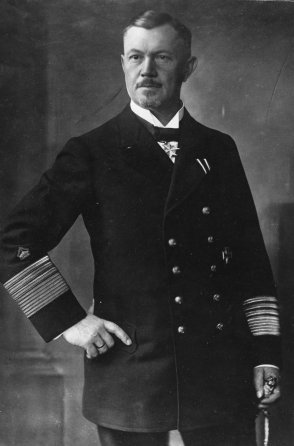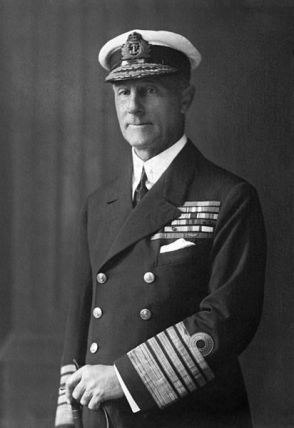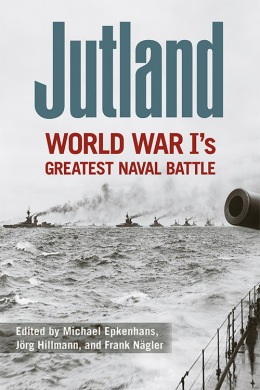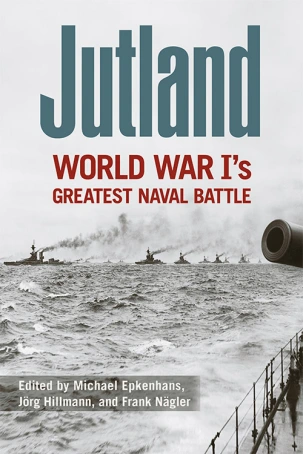100 years ago on May 31, 1916, the German and British fleets clashed in the North Sea in the only major naval engagement of World War I: The Battle of Jutland. A British loss would have been disastrous—the Royal Navy had long been a point of pride, and with almost twice the number of ships (Britain’s twenty-eight dreadnoughts against Germany’s sixteen), total victory should have been assured. But, on June 2, 1916, as the remaining ships returned to their bases, both sides claimed victory.
Britain lost more than twice the number of men and more than twice the amount of ships’ tonnage than Germany did, but retained control over the seas (though Germany’s blockade continued). What should have been a decisive battle, ended with a whimper, as both fleets took a few, last desultory shots around 3:30 am the morning of June 1.
Today, we’ll take a look at the two commanders who sought victory on the high seas: Admiral Sir John R. Jellicoe of the British Grand Fleet and Admiral Reinhard Scheer of the German Kaiserliche Marine.
Sir John R. Jellicoe, 1859-1935
Jellicoe was, in the words of Winston Churchill, the only man on either side of the conflict who could have lost the war in an afternoon. He commanded the British Grand Fleet for the first two years of the war. He was aboard his flagship, Iron Duke, at the Battle of Jutland when the two great dreadnought fleets met in their only engagement, and a British loss would have spelled disaster. Jellicoe was born of a seafaring family in Southampton and joined the Royal Navy at a typically early age: thirteen. His career was in the Mediterranean and in the Far East (he was badly wounded during the Boxer Rebellion). However, he was most talented as a planner and builder of the navy. He became a protege of Sir John Fisher, serving in the admiralty as director of naval ordnance and successively as third and second sea lord. Jellicoe had much of the responsibility for developing the new class of super battleships—including the original dreadnought—that came to dominate the balance of naval power before World War I. By August 1914, he was a vice admiral and commander in chief of the Grand Fleet. Jellicoe was therefore in control of a huge naval force that was in theory counterbalanced by a weaker but still potent German High Seas Fleet.
The long history of British naval power led to the expectation that the nation’s sailors would once again triumph at the first opportunity. However, the opportunity was long denied since the Germans (particularly the kaiser) so feared losing their hideously expensive dreadnought fleet that they refused to leave port.
Jellicoe and the Grand Fleet settled into a position of distant blockade, guarding the approaches to the North Sea from bases at Scapa Flow, Rosyth, and Cromarty. Only the respective battle-cruiser squadrons roamed the waters for the first year and a half of the war. At the end of May 1916, the German command finally decided to bring its fleet out, and Admiral Hipper was sent ahead with the battle cruisers to bait a trap for the British light squadron. Ironically, Jellicoe had the same plan, and the Grand Fleet was on the water with Admiral Beatty sent on to draw the Germans into the maw of the British dreadnoughts. The two fleets met off Jutland on 31 May. Jellicoe had a greater weight of firepower and ships, but he lacked the Germans’ better fire control systems and their speed of maneuver and communication. Despite twice approaching the line of German ships in an advantageous position, Jellicoe could not deliver a heavy enough blow, for the most part frustrated by swift German maneuvers. At the end of the day, the High Seas Fleet had escaped, leaving several British ships sunk or disabled—an inconclusive result from the British point of view, although one Jellicoe could d scarcely have prevented given the German unwillingness to fight it out. Six months later, Jellicoe was removed from fleet command and made first lord of the admiralty (Fisher had resigned over the Dardanelles debacle). In his new position, 1ellicoe ran into trouble over the issue of convoys—he was slow to accept this solution to the German U-boat menace—and he was turned out of office at the end of 1917. He was elevated to the peerage and in 1919 went to New Zealand where he became governor general the following year.
excerpted from Almanac of World War I by David F. Burg and L. Edward Purcell
Reinhard Scheer, 1863-1928

Admiral Reinhard Scheer, 1910/1916 ca. (Bundesarchiv. Bild 134-B2752)
On 18 January 1916, Vice Adm. Reinhard Scheer replaced [Admiral Hugo von] Pohl as commander of the High Seas Fleet. Pohl had fallen seriously ill and would die only a short time afterward, on 22 February 1916. Prior to replacing Pohl as commander in chief, Scheer had commanded the Third Squadron, a unit consisting of the eight most modern battleships in the navy. During that time, Scheer had not taken a stand against Pohl in any disputes concerning the deployment of the fleet and had not been inclined to pressure for a quick victory. But when Scheer took command of the fleet, two other personnel changes also took place: there was a new chief of staff, Capt. Adolf von Trotha (previously commander of the battleship Kaiser), and a new chief of the Operations Division, Capt. Magnus von Levetzow (previously commander of the battlecruiser Moltke). Thus two naval officers who had belonged to the sharpest critics of Pohl’s conduct of the war at sea gained a great amount of influence upon naval warfare. Their aim was to deploy the fleet in a more vigorous naval battle in the North Sea. By the end of January, the first draft of the new Leitgedanken für die Seekriegführung in der Nordsee (Guidelines for the Conduct of Naval War in the North Sea) was published, which was based on the assumption that the existing strength ratio precluded seeking ‘the decisive battle against the assembled English fleet.” The High Seas Fleet, it held, would have to put constant pressure upon the enemy until the latter was compelled to come “out of its present waiting stance” and advance “certain forces of theirs against us, which will present us with opportunities to attack.” The enemy must be prevented from having “such a sense of superiority . . . that he is no longer afraid to engage us in combat as he wishes.” In terms of “practical approaches” to this more offensive conduct of the naval war, the first choice was a commerce war with U-boats, followed by a mine war, a commerce war in the north, and an air war. With their airships, the navy not only had the means for an extensive reconnaissance (with radio contact to the home support bases), but also an offensive weapon that could reach the British homeland with its bombs, as was proven by the airship attacks that had begun in early 1915. In last place on this list stood “the vigorous actions by the High Seas Fleet.”
After the Battle of Jutland
The Battle of Jutland contributed to the fateful decision in favor of an unlimited U-boat war. After that, the High Seas Fleet functioned only as an assistance weapon for the conducting of the U-boat war. Its activity was limited primarily to the monotonous task of securing minesweepers on the entrance and exit paths of U-boats. On the balance, it must be stated that the operations of the High Seas Fleet reached their high point in the Battle of Jutland, yet the battle itself brought no change in the conduct of naval battles.
The High Seas Fleet remained what it had been since the outbreak of war—“a fleet in being”—which had a strategic effect just because of its very existence. Its strong presence tied up the British Grand Fleet and, along with it, the light warships that were needed in the Atlantic for security escort tasks. The fleet provided security for its own coastal area, blockaded the Baltic Sea from relief shipments to Russia, and offered the U-boat war a certain amount of support in the securing of entrance and exit routes. Thus, contrary to popular opinion of historians, who deny that it had any strategic significance, the fleet did have its military value for the German conduct of the war. Still, a sober cost-effectiveness analysis inevitably leads to the conclusion that ultimately it did not accomplish what was expected of it, or could have been expected.
In later years, the Battle of Jutland had a long-term influence on the building of tradition of the German navy that followed. It was interpreted as the defining battle experience of the years 1914–1918 and was cited as proof of validity for the German naval buildup. In the early postwar years, the official historical writing by the navy concentrated on the depiction of the battle. The semiofficial work Der Krieg zur See 1914–1918 (The Naval War 1914–1918) came to the conclusion “that the German right to claim victory in the Battle of Jutland also stands up under the most rigorous historical research.” As proof for this thesis, the German side repeatedly quoted the greater number of losses on the enemy side, without taking into account the fact that on 1 June 1916 the Germans had declined further participation in the battle with good reason. In this respect, the strategic analysis of the leadership of the North Sea battle fell short. Even after the negative war experience, leading officers of the Reichsmarine and Kriegsmarine tended to hold the opinion that one fully fought naval battle in the North Sea could have brought a strategic, decisive victory. Within the closed circle of the naval officer corps, it was considered to be a given that not even the slightest criticism was permitted against either Tirpitz or the successful fleet commanders, Scheer and [Vice Admiral] Hipper.
excerpted from Jutland: World War I’s Greatest Naval Battle, edited by Michael Epkenhans, Jörg Hillmann, and Frank Nägler





